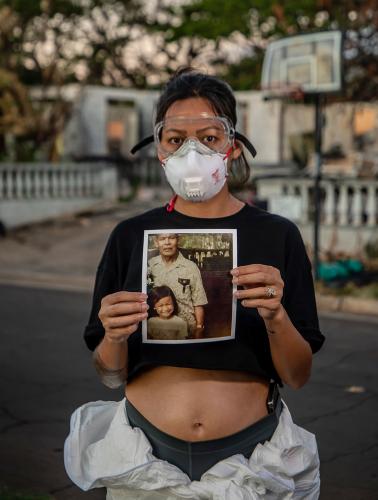August 8, 2023, is a day that Native Hawaiian Courtney Lazo will never forget. A real estate agent, she was working at her home in Lahaina, Maui’s top tourist town, where she, her husband, Jeff, and their two sons lived with her sister’s family and her 81-year-old grandmother. High winds had blown down utility poles and the family had lost power and cell phone service. About 3:30 p.m., shingles flew off their roof and hit her sister’s car. Only when she went outside to investigate did she see the wall of fire coming toward her. A fire had begun near Kula in the middle of the drought-strucken island about midnight, another later in nearby Kīhei and then early that morning, a brushfire erupted near Lahaina in West Maui. “By the time we knew there was a fire, it had already burned Front Street,” she recalled.
Her uncle evacuated her grandmother and the one son who was at home to the other side of the island while she and Jeff rounded up their five dogs. They escaped just as the flames reached their home. However, more than 100 others on the island did not survive, and some 2,200 structures, including significant cultural sites, became toxic wastelands. Lazo said, “Many homes had been in those families for 100 years.”
The fires burned until August 13, displacing nearly 10,000 of Maui’s 160,00 residents. The Federal Emergency Management Agency, state, county and other partners have provided almost 8,000 people temporary housing, of which 5,000 are still there. Many are being moved from hotel room to hotel room as Maui’s 3 million annual tourists have begun flooding the island again. Lazo joined Lahaina Strong, a group dedicated to securing housing for the fire’s survivors. Many took turns camping on the island’s Kā‘anapali Beach to bring attention to the need. More than 70 percent of housing in West Maui is owned by nonresidents. So if another disaster hits, she said, “There is nowhere to go.” In addition, the group is supporting bills to protect Hawai‘i homeowners and renters from foreclosure or price gauging following a disaster and to enable Hawai‘i counties to phase out short-term vacation rentals through zoning.
Tlingit photographer Zoë Urness visited Lazo’s family members in December 2023, when they were finally able to comb through their house’s rubble. Urness watched as Lazo’s sons shoveled in vain to locate the sidewalk that they had pressed their handprints into as children. Fortunately, just months earlier, Lazo had snapped some pictures of her grandmother’s photos, including one of Lazo and her grandfather standing outside their home that he had built. Today, a fence, some walls and those photos are all that remain of their multigenerational home.
Although Lazo’s family has temporary housing, she continues to fight for Maui residents who do not. She and Jeff, whose construction business was consumed in the fire, plan to rebuild their family’s lives in Lahaina—all while waiting for the birth of their third child. Urness said of Lazo, “She’s a remarkable woman.” Lazo said, “We are very determined we all get to go home one day, and that it is safer when we do.”

